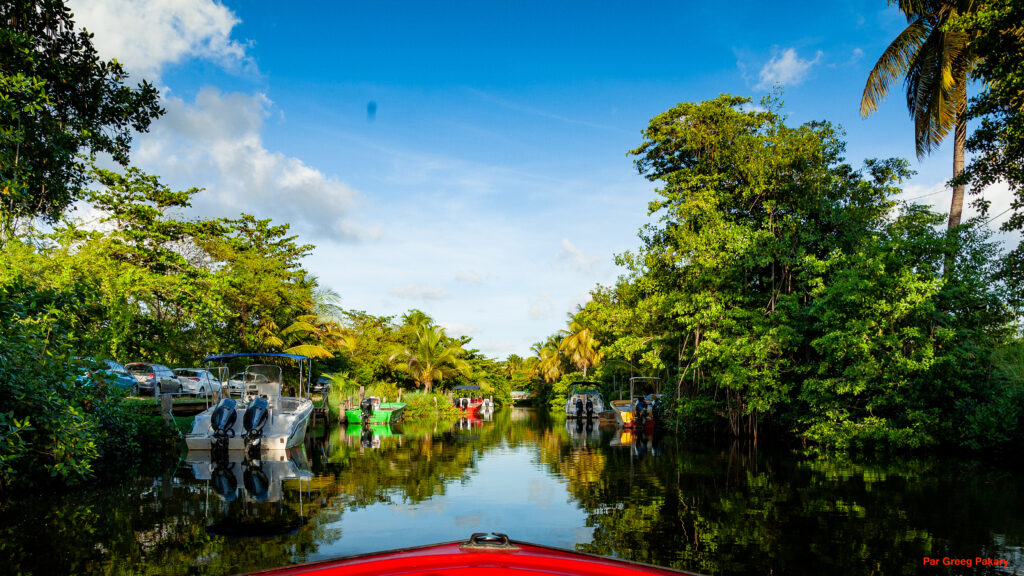
Rotours channel
Description
Located in the commune of Morne-à-l’eau, the “Canal des Rotours” was dug over nearly 6 kilometers by more than 300 free or enslaved men between 1826 and 1829. It begins in the Grippon’s plain, crosses the town, and flows into the Grand-Cul-de-Sac Marin at Pointe à Feuille, not far from Vieux-bourg.
This canal originates in the continuity of the Coudes’ gully, which crosses the plain of Grippon from one end to the other. Built as early as the 18th century for the drainage (drying and sanitation) of the marshy area of Grande-Terre, it also allowed for the development of agriculture and an acceleration of rivertransport of goods and raw materials between this part of Grande-Terre and Pointe-à-Pitre (notably with the sugar industry).
Later, with the arrival of vehicles and the construction of road networks, its use and that of neighboring canals (Pointe à Retz, Pinette, or Perrin) declined sharply. During the long years of abandonment, the Canal des Rotours continued to perform its role in draining and protecting the town during rainy periods. It is also used for the management of wastewater. Fortunately, since the end of the 20th century, various associations have taken an interest in it, cleaning and maintaining it to ensure its navigability and to address the pollution it is subjectto. In 2019, the ONF* (National Forest Office) and the DEAL* (environment, urban planningand housing department) undertook a cleaning project with the aim of ensuring the free flow of water and a scenic aspect that allows for leisure activities (kayaking) as well as boat fishing to reach the Grand-Cul-de-Sac marin. In fact, it is a real interior fishing port in the middle of the town of Morne-à-l’Eau, serving as a tourist port for the Grand-Cul-de-Sac Marin
Biodiversity
This canal constitutes a nursery extending the mangrove, especially in the first two kilometers to the west. Communicating with the Grand-cul de sac Marin, the red, black, gray and whitemangroves, present shelter and feed fish and crustaceans (mangrove crab (Scylla serrata), dwarf swimming crab (Liocarcinus pusillus), swamp ghost crab (Ucides cordatus) or sandfiddler crab (Uca pugilatoroLeptuca pugilator)), mammals (rats, can find mongooses (belonging to the Herpestidaefamily), raccoons (Procyon lotor) )and birds (Guadeloupe woodpecker (Melanerpes herminieri), snowy egret (Egretta thula) and Carib grackle (Quiscalus lugubris) among others). Its wealth and tranquility make this place a breeding area. Until the beginning of the 20th century, it was also home to manatees, now decimated by excessive fishing destined for the metropolis
ECOTOURISM POTENTIAL
The canal, the basis of Morne-à-l’Eau’s urban and ecotourism development strategy, is part of the history of its territory. In addition to his flora and fauna interests, it participates from the titles “city-nature” and “best city for biodiversity” obtained by the town of Morne-à-l’Eau. On the other hand, projects such as the City of Water and Biodiversity, in order to make knowledge of the territory and its biodiversity accessible to everyone, encourage an eco-friendly kind of tourism as much as possible.
The Canal des Rotours, is a heritage with a history and a nature to discover, the refore, whetherby kayak or in its developing environment, is a good placeto visit. It also provides a good example about the rehabilitation and maintenance of our natural spaces
Link to Canal des rotours–general advice
PATRIMOINE / ” La route de l’esclave”-Canal des ROTOURS Canal viewed from a boat Source : wikipédia.fr


Canal viewed from a boat Source : wikipédia.fr

Canal des Rotours seen from the sky
Source : juliendorol.com
Informations
-
-
Location
Guadeloupe (Morne-à-l'eau)

